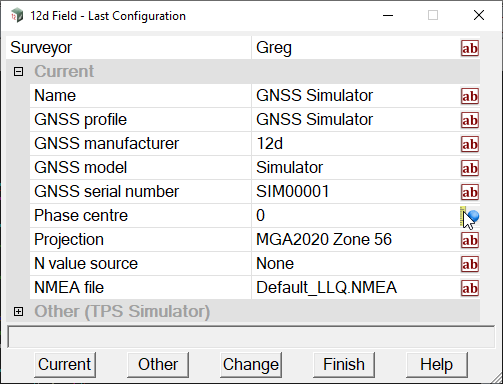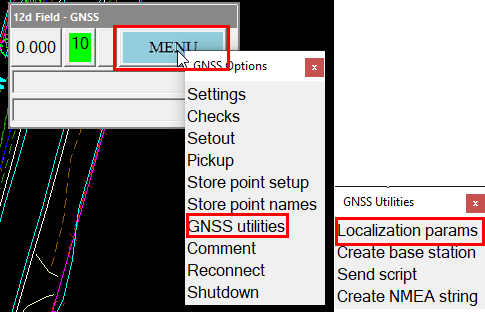Major changes from V14 to V15
There are 3 things you will observe when migrating from V14 to V15
- Your V14 helmert file will not work in V15
- You cannot find the Localisation panel in V15
- When you bring up the panel there is nowhere to enter an Ellipsoid TIN (Geoid TIN/N_value)
These 3 things are by design. The process has been made simpler with less files to copy around. It has also been made more robust, and 12df now checks that all points used were observed with the same projection/N_values settings.
You cannot find the Localisation panel in V15
The panel is now accessed from within 12df. Rather then connect to an instrument, 12df can be started in GNSS simulator mode.


When you bring up the panel there is nowhere to enter an Ellipsoid TIN (Geoid TIN/N_value)
Again, this is by design, and results in a major change to our workflows.
From 12df V9 to V14 our workflow was to do our observations without any geoid correction being made. Then when we calculated our localisation allowance for the Geoid TIN could be made.
In V15 we need to make a decision before we observe our localisation points.
Do we want to use a Geoid with our localisation? If yes, then the points need to be surveyed using a GSB at the time of the observations.
For information on this please see:
12df V15: Using a GSB for N_values instead of Winter files and *.TDF_HEL
The V15 Localisation Panel
Note: The fields highlighted in green have been read from 12df startup. They cannot be edited.

The old Ell -> MSL field is no longer available.
Create Local TIN has been replaced by Local-n-value type.

There are now 4 choices under Local n-value type:
None: Don’t use one
Plane: Equivalent of the old Local TIN. Is now written directly into the helmert.12dfield file, so no TIN files to copy 🙂
String: New type that is related to the Chainage of an Alignment. Think of out the back of nowhere, Newell Highway, control down the corridor with nothing outside the corridor. Planes can easily tilt. 12df will just adopt the residual at each observed point, and proportion the difference along the alignment.
Trimesh: Warts and all, or a “forgiveness TIN”. Just adopts the residuals, writes them to a Trimesh (TIN) and proportions the residuals by the TIN. Again, written directly into the helmert.12dfield file, so no TIN files to copy 🙂
Can I copy my V14 localisation to V15. No, but yes..
We cannot directly migrate the file, but we can save ourselves a heap of work/pain by copying the grid of the points used.
Please watch the short video below to see how to copy your V14 localisation file to V15.